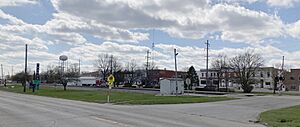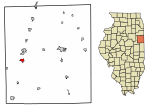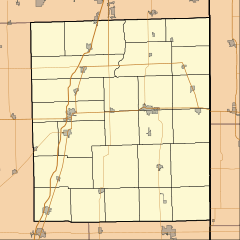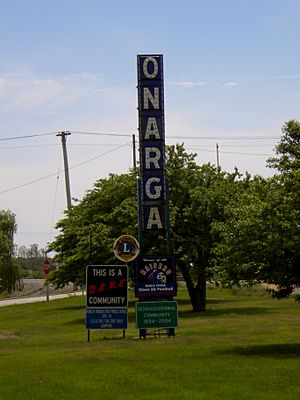Onarga, Illinois facts for kids
Quick facts for kids
Onarga, Illinois
|
|
|---|---|
|
Village
|
|
 |
|

Location in Iroquois County, Illinois
|
|
| Country | |
| State | |
| County | Iroquois |
| Township | Onarga |
| Founded | 1854 |
| Area | |
| • Total | 1.67 sq mi (4.33 km2) |
| • Land | 1.67 sq mi (4.33 km2) |
| • Water | 0.00 sq mi (0.00 km2) |
| Elevation | 669 ft (204 m) |
| Population
(2020)
|
|
| • Total | 1,333 |
| • Density | 796.30/sq mi (307.50/km2) |
| ZIP code |
60955
|
| Area code(s) | 815 |
| FIPS code | 17-56081 |
Onarga is a small village located in Iroquois County, Illinois, in the United States. In 2020, about 1,333 people lived there. It's a quiet place with a unique history and a special connection to plants!
Contents
Exploring Onarga's Location
Onarga is found in the western part of Iroquois County. A main road, U.S. Route 45, goes right through the middle of the village. This road can take you north to Gilman (about 4 miles away) or south to Buckley (about 8 miles away).
A big highway, Interstate 57, runs along the western edge of Onarga. You can get on or off this highway at Exit 280. If you head north on I-57, you'll reach Kankakee in about 31 miles. Going south will take you to Champaign, which is about 46 miles away. The big city of Chicago is about 90 miles north of Onarga, also along I-57.
The village covers a total area of about 1.67 square miles (4.33 square kilometers), and all of it is land.
Onarga's Weather and Seasons
Onarga experiences four clear seasons, much like many places in the Midwest.
- Winter is cold, with snow often falling. Temperatures can sometimes drop very low, even to -10°F or -20°F.
- Spring is usually mild, but it can be rainy, windy, and cloudy. Temperatures slowly warm up from the 50s in March to the 80s by early June.
- Summer is hot and humid. Short but strong thunderstorms are common. Average summer high temperatures are in the mid to upper 80s, sometimes reaching the lower 90s.
- Autumn is cooler and drier. The first frost usually happens in mid to late October.
The warm, humid summers in Onarga are perfect for growing corn and soybeans. These crops are very common in the fields around the village. Onarga gets about 40.44 inches of rain each year.
A Look Back at Onarga's History
Onarga was first planned in the mid-1800s when the railroad was being built from Chicago. Because it was close to Spring Creek, Onarga was one of the first places settled in Iroquois County. The town grew quickly at first, but its population has stayed about the same for a while now.
The name "Onarga" probably comes from an Iroquois word that means "a place of rocky hills."
Onarga: The Nursery Capital
Onarga is known as "The Nursery Capital of the Midwest." This is because it has tree and shrub nurseries that have been in business for over 100 years! Instead of just corn and soybeans, you'll see many rows of trees and bushes in the fields around town.
These successful nursery businesses have brought many different people to Onarga. Many Mexican and Mexican-American migrant workers have chosen to make Onarga their home.
In 2004, Onarga celebrated its 150th birthday (called a sesquicentennial) with a festival that lasted almost a week. It included fun events and a focus on the village's history.
Onarga is also the final resting place of Timothy Webster, a spy from the American Civil War who worked for the Pinkerton detective agency. Allan Pinkerton, who founded the Pinkerton agency, also had a weekend home in Onarga called The Larches.
Things to Do in Onarga
Onarga has a few places for fun and relaxation. You can find a golf course, several restaurants, and a place called Lake Arrowhead. The only movie theater in all of Iroquois County is located right here in Onarga!
| Historical population | |||
|---|---|---|---|
| Census | Pop. | %± | |
| 1880 | 1,061 | — | |
| 1890 | 994 | −6.3% | |
| 1900 | 1,270 | 27.8% | |
| 1910 | 1,273 | 0.2% | |
| 1920 | 1,302 | 2.3% | |
| 1930 | 1,469 | 12.8% | |
| 1940 | 1,413 | −3.8% | |
| 1950 | 1,455 | 3.0% | |
| 1960 | 1,397 | −4.0% | |
| 1970 | 1,436 | 2.8% | |
| 1980 | 1,269 | −11.6% | |
| 1990 | 1,281 | 0.9% | |
| 2000 | 1,438 | 12.3% | |
| 2010 | 1,368 | −4.9% | |
| 2020 | 1,333 | −2.6% | |
| U.S. Decennial Census | |||
Who Lives in Onarga?
In 2020, there were 1,333 people living in Onarga. The village had 407 households, and 273 of these were families.
- About 26.5% of the people were under 18 years old.
- About 16.8% were 65 years old or older.
- The average age in the village was 36.6 years.
The median income for a household in Onarga was about $48,024. This means that half of the households earned more than this amount, and half earned less. For families, the median income was about $54,896.
See also
 In Spanish: Onarga (Illinois) para niños
In Spanish: Onarga (Illinois) para niños



